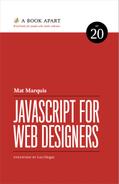RESOURCES
So, where to from here? An entire programming language is sprawling out before you. Well, there are plenty more books to read—and read them you should—but now that you know what to look for, there’s no substitute for reading code. Take a little time to read through the scripts you’ve seen flying around a project at work, or dig into the code that powers your favorite open source tools. There’ll be a lot more going on than we’ve covered here, but I bet you’ll recognize more than you think.
Next steps
- Mozilla Developer Network. If you’ve made it this far, it’s time I revealed the secret to a successful career in professional JavaScript development: cheating. JavaScript is too much for any mortal to commit to memory. When the time comes to look something up, whether it’s about capitalization or browser support—and that time will come, more than once per day—MDN is the place to do it (http://bkaprt.com/jsfwd/07-01/).
- Responsible Responsive Design, Scott Jehl. Progressive enhancement is a concept we barely touched on, but it formed the foundation for the script we built. JavaScript enhancements aren’t always guaranteed to be available to your users, and not just because users have turned it off at the browser (though some do). Responsible Responsive Design is a closer look at inclusive front-end development practices, from progressive enhancement to accessibility to performance (http://bkaprt.com/jsfwd/07-02/).
- If Hemingway Wrote JavaScript, Angus Croll. You might not know it from my Twitter account, but I’m a pretty big fan of the written word. If Hemingway Wrote JavaScript is an imagined look at the coding styles of authors like Jane Austen and William Shakespeare, based on their writing. Not all of it is in JavaScript, but every language you’ll encounter is made of the principles you’ll be familiar with now. It’s a fun way to look at the signatures people leave on their code (http://bkaprt.com/jsfwd/07-03/).
Digging deeper
Now you’ve got enough of a foundation to get into JavaScript in a major way. If you’re champing at the bit to learn more advanced JavaScript and you’re excited to keep on unraveling JavaScript puzzles, I’ve got more reading material to share.
- Eloquent JavaScript, Marijn Haverbeke. You won’t find the tenor of this book terribly unfamiliar, unless you skipped right to the end of the one you’re reading now: Marjin draws a similar path through the concepts of JavaScript, though they’re going to come at you a little faster and in grittier detail http://eloquentjavascript.net/).
- JavaScript Patterns, Stoyan Stefanov. I’ve come back to this book a few times over the course of my career. I’d read through it until I felt like I’d gotten a little lost, then put it down for a while. With time and experience, I’d end up landing a little further into the book each time—and, in doing so, find countless ways to reexamine parts of JavaScript I thought I knew inside and out (http://bkaprt.com/jsfwd/07-04/).
- Effective JavaScript: 68 Specific Ways to Harness the Power of JavaScript, David Herman. Like others in this list, Effective JavaScript isn’t the lightest read. It is, however, a highly approachable follow-up to the concepts we’ve covered together, all packaged up as an indispensable list of best practices and useful advice (http://effectivejs.com/).
..................Content has been hidden....................
You can't read the all page of ebook, please click here login for view all page.
